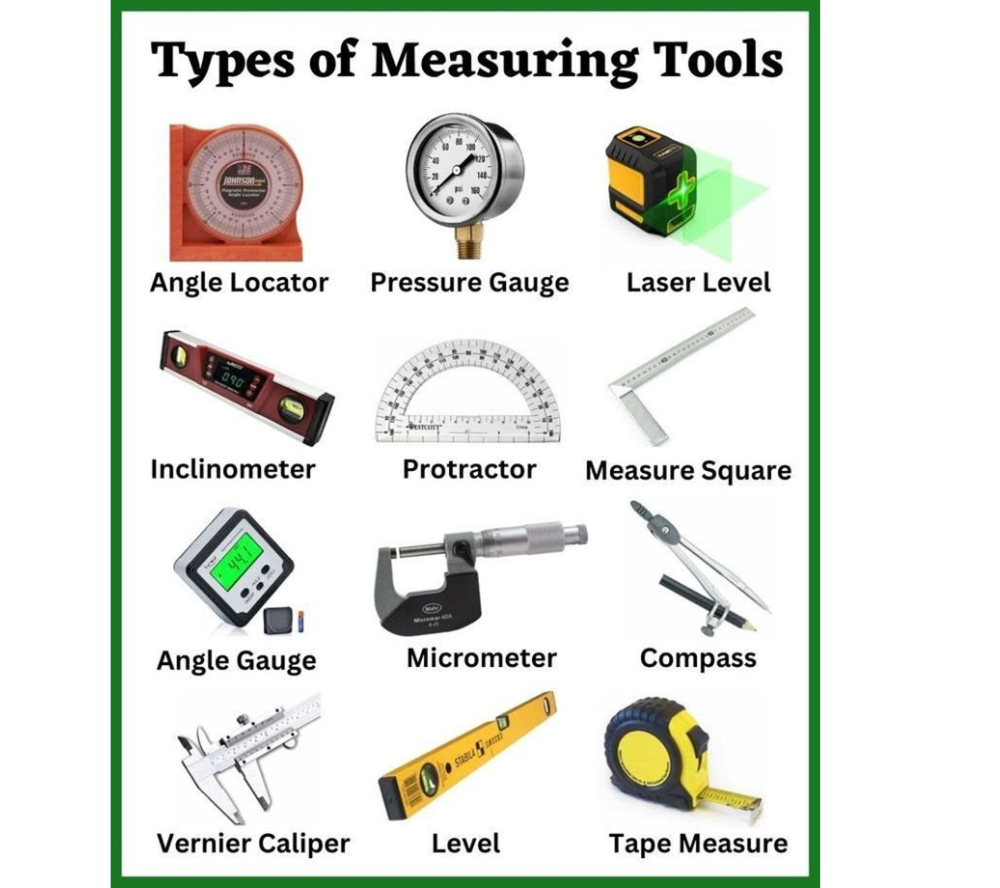Types of Measuring Tools Description
The image titled “Types of Measuring Tools” is a visually organized guide that highlights twelve critical instruments used for precise measurements across various applications, including woodworking, construction, engineering, and more. Each tool is presented with a clear label and a high-quality image, making it an excellent resource for beginners and professionals alike. The tools are arranged in a grid format with a green border, and the title is prominently displayed at the top in bold, black text. This guide is particularly useful for ensuring accuracy in projects where precision is paramount.
1. Angle Locator
The angle locator, shown in the top left, is a Johnson brand tool designed to measure and transfer angles. Its circular dial with degree markings and adjustable arms make it ideal for determining the angle between two surfaces, often used in carpentry and metalworking.
2. Pressure Gauge
Next is a pressure gauge, a circular instrument with a needle and a scale ranging from 0 to 150 PSI. This tool measures the pressure of gases or liquids, commonly used in automotive, HVAC, and industrial applications to ensure systems are operating within safe parameters.
3. Laser Level
The laser level, depicted on the top right, projects a green laser crosshair for precise leveling and alignment. This tool is invaluable in construction and interior design for ensuring straight lines and level surfaces over long distances.
4. Inclinometer
The inclinometer, shown in the second row, is a digital tool with a display screen showing angle measurements. It’s used to measure the angle of slope or tilt, making it essential for tasks like setting the pitch of a roof or aligning machinery.
5. Protractor
A classic protractor, typically made of transparent plastic, is featured next. With degree markings from 0 to 180, it’s a simple yet effective tool for measuring and drawing angles, widely used in geometry, drafting, and woodworking.
6. Measure Square
The measure square, also known as a combination square, is a versatile tool with a ruler and a 90-degree angle head. It’s perfect for marking perpendicular lines, measuring depths, and checking angles, making it a staple in woodworking and metalworking.
7. Angle Gauge
The angle gauge, shown in the third row, is a digital device with a small screen displaying angle measurements in degrees. It’s used for measuring the angle between two surfaces, often in applications like woodworking or automotive repair.
8. Micrometer
The micrometer, a precision instrument, is designed for measuring small distances with high accuracy, down to fractions of a millimeter. It’s commonly used in engineering and machining to measure the thickness or diameter of small components.
9. Compass
A traditional drafting compass, complete with a pencil, is included for drawing circles and arcs. This tool is essential in design, drafting, and woodworking for creating precise circular patterns or layouts.
10. Vernier Caliper
The vernier caliper, shown in the bottom row, is a precision tool for measuring internal and external dimensions, as well as depths. Its sliding scale and fine adjustments make it a go-to for engineers and machinists requiring exact measurements.
11. Level
The level, a Stanley brand tool, features a bubble in a liquid-filled tube to indicate horizontal or vertical alignment. It’s a fundamental tool in construction, carpentry, and masonry for ensuring surfaces are level or plumb.
12. Tape Measure
Lastly, the tape measure, a familiar tool also featured in the “12 Essential Woodworking Tools For Beginners” guide, is shown in a yellow retractable design. It provides quick and easy measurements of length, essential for any project requiring dimensional accuracy.
Connection to Woodworking Tools
This guide complements the “12 Essential Woodworking Tools For Beginners” post by including overlapping tools like the tape measure and measure square (similar to the speed square in the woodworking list). While the woodworking guide focuses on tools for cutting, joining, and finishing, this measuring tools guide emphasizes precision and accuracy, which are critical in woodworking and other fields. Together, these resources provide a well-rounded toolkit for beginners embarking on woodworking or similar projects.
This collection of measuring tools ensures that users can achieve precision in their work, whether they’re building furniture, designing structures, or working on mechanical projects. Each tool serves a unique purpose, from measuring angles and distances to ensuring level surfaces, making them indispensable for any task requiring accuracy.

